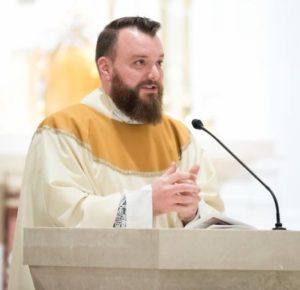 Dear Brothers and Sisters in Christ,
Dear Brothers and Sisters in Christ,
The season of Lent began with the charge to “Repent and believe in the Gospel.” In the last two weeks, we have reflected on the way in which repentance means a turning away from sin and toward God. This reorientation of our hearts and lives can be described as a movement ad orientem, to the east, to Christ who is the rising sun. Ad orientem then, is for Catholics a turn to the Lord. Because we are a union of body and soul, Catholic prayer is always an incarnate spiritual reality. We pray with words, with the mind, with the heart, and even with the body. The Lenten discipline of prayer helps us remember the nature of our turn to the Lord. Prayer is the movement of heart and mind that allows us to reorient our lives for God’s grace and glory. The body itself is an aid to prayer; by our posture and gaze, with ears and eyes we are able to be more aware of God’s loving presence, which in turn facilitates the interior orientation of our hearts toward the Lord. As we move ad orientem, toward the Lord, prayer is that movement that makes possible all the other ways in which God is asking us to orient our lives.
Aware that the body is involved in prayer just as much as the heart, the Church has always recommended the practice of fasting. This discipline applies first to foregoing food for a period of time. Related to this is the practice of fasting from a particular kind of food, as when we abstain from meat on Fridays. In a secondary way, fasting can describe the temporary (or in some cases permanent) elimination of a particular activity from our lives. During Lent, some might give up television or social media, for example. Fasting is a deeply rooted tradition and practice meant to help us discipline ourselves in body and mind, and in so doing, learn the discipline necessary to live virtuously. It has a penitential character, in that going without things we like is a voluntary suffering. For Catholics, fasting is meant to be a regular part of our lives, both so that we can choose to do penance and so that we can grow in those skills that are so essential for a healthy spiritual life and friendship with God. In this, the Church is not unique; nearly every religion in the world practices some kind of fasting. Even the secular world encourages fasting for its various health benefits and the self-mastery it can teach. What is it that sets fasting apart for us in a Catholic, Lenten context?
First, let’s understand fasting at its most basic: not eating. Twice a year (on Ash Wednesday and Good Friday), the Church asks all Catholics aged 14-60 to undertake a day of fasting and abstinence. The parameters are simple – no meat, and only one meal during the day. Two smaller meals not equal to the main meal are also permitted. Now, if we’re being honest, that is not a very hard thing to do for most people. Fasting has traditionally been a more rigorous practice, and many people are accustomed to a more rigorous fast in anticipation of medical procedures or as part of a diet and exercise regimen. In Christian history, fasting has been practiced with regularity throughout the year with the Lenten fast representing an intensification of the discipline. Fasting allows us to turn ad orientem toward the Lord. The feeling of hunger it brings is a small suffering we can offer to the Lord, a physical reminder of our spiritual hunger for union with God, and an act of endurance that teaches us self-control, lessons we can apply in other areas of our lives each day. A modest suggestion, then: look at your calendar and set aside one day each week during Lent (Fridays, for example) to observe the same fast called for on Ash Wednesday and Good Friday. Learning to practice fasting in Lent can then carry over into other times of the year.
A subset of fasting is the practice of abstinence. In Lent, this is uniformly observed by all Catholics as we abstain from meat. Interestingly, the Code of Canon Law (the law governing the Church) in canon 1251 calls for abstinence from meat every Friday of the year, though local bishops’ conferences can adjust the practice. In the US, the bishops call for abstinence from meat, though this penance can be substituted (rather vaguely, in my opinion), by some other penance or work of charity. In any case, abstaining from meat on Fridays reminds us that Friday is the day Jesus dies, in the flesh, on the Cross. Thus, we do not consume the flesh of any animal on that day. The practice of abstinence as a subset of fasting challenges us to be more intentional about our eating. Under this category we also find the answer to the oft-repeated question, “What are you giving up for Lent?” During Lent we abstain from some food, drink, activity, or combination thereof as a way of denying ourselves some small pleasure for the sake of bodily discipline, atonement for our sins, and ongoing penance that causes us to turn our minds and hearts more completely to the Lord.
We should make note here of the differences between fasting and diet, as well as their similarities. In the Catholic context, whether in Lent or any other time in the year, fasting is a bodily practice done for a spiritual purpose. We do not fast to lose weight, but to lose sin; we do not fast to get a better figure, but to build a stronger soul. A diet, on the other hand, is something we do for the benefit of our physical health. But diet and fasting are more related than we might realize at first. How often do people go on diets, for example, right at the beginning of the year, only to once again need a diet in time for beach season? Diet can easily become something done solely for a time and then forgotten, meaning that the benefits of the diet are overcome by the consequences of not dieting. In a similar way, fasting in Lent can be very beneficial, but if not practiced through the year, those benefits fade. Both diet and fasting, in order to provide lasting benefits, need to have consistency over time. The goal of Lent is to train us in the disciplines necessary for lasting conversion of heart, the disciplines that allow us to turn ad orientem and remain thus turned to the Lord in all things.
And so some practical ideas for fasting. First, we should be realistic about our fasting. Abstinence from meat or other foods, drinks, or activities can very easily be practiced by anyone. More intense fasting and overall food-intake reduction should happen with thought, planning, and intention. Fasting should not be taken to extremes without consultation with a spiritual director, just as a diet should not be taken to extremes without prior consultation with a physician. Second, we should prepare for fasting. Practicing small fasts can help us build to a more significant fast. For some excellent ideas on fasting that can be adopted throughout the year, I suggest reading Jay W. Richards’ book “Eat, Fast, Feast.” Richards is a Catholic who ably connects the spiritual discipline of fasting with the idea of long-lasting change in habit, behavior, and spirituality. Finally, whenever we fast, we should remember to have an intention for the fast. For what are we praying, for whom are we offering our suffering, for what do we wish to atone? At the start of the fast, we should prayerfully offer it to God. During the most difficult parts of the fast, we should turn once again to the Lord in prayer to offer up the very small sufferings we endure, and as the fast ends, we should turn to God with grateful hearts for the ways His grace sustains and carries us. When we make fasting a consistent part of Lent, and when we practice it throughout the year, we find an outstanding discipline that helps us to reorient and remain oriented, turned toward Christ, the suffering servant, the Light of the world.
Peace,

Fr. Sam


